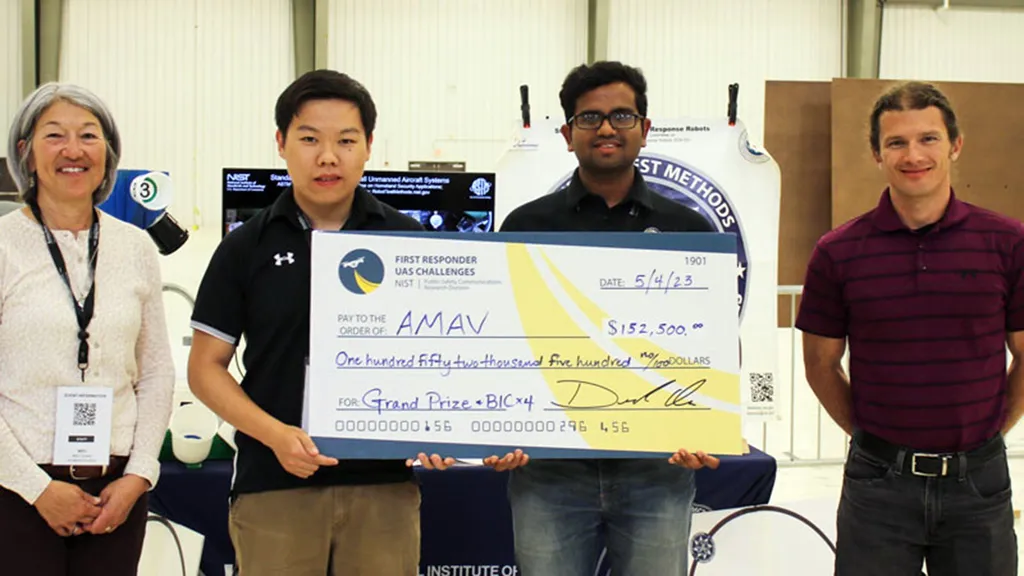- May 15, 2023
- By Jennifer Figgins Rooks
A University of Maryland team hustled a compact drone through doors, down hallways and past obstacles to beat out 10 fellow competitors in a search-and-rescue-themed competition earlier this month and bring home the grand prize of $150,000.
UMD’s Autonomous Micro Air Vehicle (AMAV) team not only won the final round of the National Institute of Standards and Technology (NIST) First Responder UAS Indoor Challenge—after winning a similar NIST-sponsored competition last year—but scored four out of the six Best-in-Class awards. The event at Kansas State University simulated a rescue indoors after a hypothetical earthquake rendered a building interior hazardous for human rescuers and featured a course with faux debris and victims in need of help.
“It was an incredibly challenging environment to design for,” said Animesh Shastry, an aerospace engineering Ph.D. student and the team leader. “Imagine a multistory building with ceiling tiles and wires hanging down, furniture tipped over, and mannequins under mattresses and just junk everywhere, with debris and dust in the air.”
To address the unique challenges of indoor flight, the team developed an agile, compact drone they dubbed Gambit that used an advanced onboard sensing system enabling it to fly without the use of GPS.
“It’s a technique called visual odometry,” said Derek Paley, professor of aerospace engineering, director of the Maryland Robotic Center, and the team’s adviser. “Onboard cameras allow Gambit to localize features and deduce its own motion relative to those features. It can hold its position with incredible stability and maneuver much more reliably even in the absence of GPS.”
Gambit also features thermal, high-definition (HD), and night-vision cameras on a gimbal with 180-degree range so it can still “see” in a dark environment. However, all of this technology had to be developed to be as cost-effective as possible per NIST competition guidelines.

Maryland’s team did it for $5,000, compared to industry models costing over $50,000, Paley said.
Beyond cost, the team wanted to take first responders’ needs into consideration in its design. Through Maryland’s I-Corps Program, an NSF-funded initiative that offers entrepreneurial training, team members were able to interview EMTs, police officers and firefighters.
“We learned that reliability was one of the top features,” said Qingwen Wei, a senior in aerospace engineering and the team’s design lead and pilot, “which is also why we dedicated so many hours to testing our drone, to find all of the bugs and work out any issues.”
The team took the advice to heart, and by competition time could deploy Gambit into action in under two minutes, while other competitors took much longer. In search and rescue, where minutes lost can cost lives, rapid deployment is critical.
“Our design was also very safe because all of our wires and the rotors were enclosed,” Wei said “So, if we hit an obstacle, the drone would bounce off, instead of getting entangled or getting shut off.”
The AMAV Team also won the 2021 NIST UAS FastFind Challenge 3.1, which required it to find multiple missing persons in more than 70 acres of forest. Looking ahead, the student engineers are exploring options for improving and commercializing Gambit, based on interest from the competition’s sponsors and attendees. Although the market for drones is saturated at the moment, Gambit’s combination of capability and cost make it one-of-a-kind, Paley said.
In the meantime, however, the NIST 2023 challenge was announced, and the team is already thinking about its next entry.
